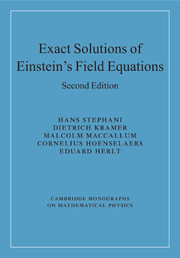Book contents
- Frontmatter
- Contents
- Preface
- List of tables
- Notation
- 1 Introduction
- Part I General methods
- 2 Differential geometry without a metric
- 3 Some topics in Riemannian geometry
- 4 The Petrov classification
- 5 Classification of the Ricci tensor and the energy-momentum tensor
- 6 Vector fields
- 7 The Newman–Penrose and related formalisms
- 8 Continuous groups of transformations; isometry and homothety groups
- 9 Invariants and the characterization of geometries
- 10 Generation techniques
- Part II Solutions with groups of motions
- Part III Algebraically special solutions
- Part IV Special methods
- Part V Tables
- References
- Index
8 - Continuous groups of transformations; isometry and homothety groups
from Part I - General methods
Published online by Cambridge University Press: 10 November 2009
- Frontmatter
- Contents
- Preface
- List of tables
- Notation
- 1 Introduction
- Part I General methods
- 2 Differential geometry without a metric
- 3 Some topics in Riemannian geometry
- 4 The Petrov classification
- 5 Classification of the Ricci tensor and the energy-momentum tensor
- 6 Vector fields
- 7 The Newman–Penrose and related formalisms
- 8 Continuous groups of transformations; isometry and homothety groups
- 9 Invariants and the characterization of geometries
- 10 Generation techniques
- Part II Solutions with groups of motions
- Part III Algebraically special solutions
- Part IV Special methods
- Part V Tables
- References
- Index
Summary
In this chapter we shall summarize those elements of the theory of continuous groups of transformations which we require for the following chapters. As far as we know, the most extensive treatment of this subject is to be found in Eisenhart (1933), while more recent applications to general relativity can be found in the works of Petrov (1966) and Defrise (1969), for example. General treatments of Lie groups and transformation groups in coordinatefree terms can be found in, for example, Cohn (1957), Warner (1971) and Brickell and Clark (1970), but none of these cover the whole of the material contained in Eisenhart's treatise.
Einstein's equations have as the possible generators of similarity solutions either isometries or homotheties (see §10.2.3). Hence we treat these types of symmetry here, the other types of symmetry, which are more general in the sense of imposing weaker conditions, but are more special in the sense of occurring rarely in exact solutions, being discussed in Chapter 35. Isometries have been widely used in constructing solutions, as the results described in Part II show. Many of the solutions found also admit proper homotheties (homotheties which are not isometries), and these are listed in Tables 11.2–11.4, but only since the 1980s have homotheties been used explicitly in the construction of solutions.
Information
- Type
- Chapter
- Information
- Exact Solutions of Einstein's Field Equations , pp. 91 - 111Publisher: Cambridge University PressPrint publication year: 2003
